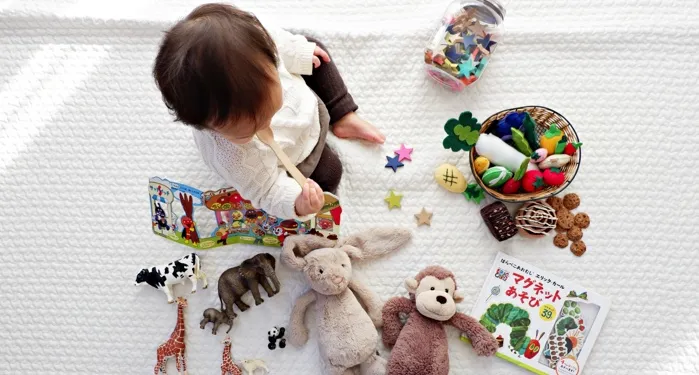As a librarian, I get a lot of questions about how to make sure that children grow up to love books and reading. For avid readers, reading with their kid is an exciting part of becoming a parent and building literacy skills is something they look forward to doing together. While babies and young toddlers are years away from independent reading, there are ways to start promoting literacy skills from a very early age. Below, I’ve put together some simple advice and book recommendations for parents who want to incorporate reading right from the start in a way that is both enjoyable and developmentally appropriate.
Ways to Promote Literacy
Expose Your Child to Books as Objects
One of the earliest understandings children can develop is that symbols and pictures have meaning. Before your baby can talk, they can grasp that letters printed on a page cause you to make certain sounds, and by reading in front of them you help them understand the purpose of written language. As adult readers, we don’t even think about certain aspects of books, like the fact that English language books are read from back to front, but by reading with and in front of your baby, you can expose them to these concepts. Exposure to how books work will help build skills and confidence for your child to eventually pick up books on their own!
Choose Books Your Baby Can Play With and Even Chew On!
While letting your 6-month-old mouth on the corner of a book may seem counterintuitive, letting babies explore books in their own way helps them enjoy being read to even more! Before 12 months, your child may not be very interested in sitting to be read to or turning the pages of the book, but activities like chewing on books or using them as playthings are great ways to expose your baby to books when they’re younger. Try tactile books like
That’s Not My Monster! to help your child get used to different textures.
Choose Books With Unique Vocabulary and Situations
One important aspect of reading for older children in the vocabulary building opportunities it gives them. When children read (or are read to) they get the opportunity to hear words that might not come up in their everyday lives. You can mimic these benefits with young children by purposefully choosing books that introduce vocab and concepts they might not otherwise here. For example, try a book like
Moo, Baa, La, La, La that has you making silly sounds your baby might not have heard before!
Incorporate Rhyming and Language into Everyday Activities
Siting down to read a book together may not realistically fit into your schedule, or your baby just may not be interested. While exposure to printed books is great, you can also build vocabulary and language skills during everyday activities. Use new and complex words to describe your baby’s everyday activities to them…maybe they’re “nuzzling” their favorite blanket or “chowing down” on their meals. You can further cement literacy in our everyday interactions by using books like
Where is Baby’s Belly Button? or
Besos for Baby to emphasis new words, have some active play time, and help your baby cement the connection between the symbols in a book and your words and movements.
What Types of Books?
Black and White Illustrations
As soon as they’re born, babies are working on developing eyesight and recognition. Some of the earliest developments in this area come from 0 to 3 months, when babies are drawn to high contrast images. Try books like
Look, Look! or
Black & White that very young babies can enjoy for their bold images and use of shapes.
Bright Colors
From 4 to 6 months, many babies start to be interested in bright colors and board books with short, punchy sentences. There are lots of great, colorful books out there, including the artsy
Pantone Board Books and C
olors by John J. Reiss.
Faces (Especially of Other Babies!)
From seven to nine months, babies love looking at faces. Let them explore books like
Hey, Baby!, Hello Baby: Faces, and
Baby Faces that also provide short text that describes basic daily routines and emotions. This is also a great age to begin introducing alphabet books like
A is for Activist to your baby.
Rhyming Words
Rhymes and sing song language are soothing for babies and as they move toward 12 months of age, babies are able to engage with longer chunks of text. Try books like
Whose Toes Are Those? for funny rhymes or
Girl of Mine for a soothing bedtime story.
Further Resources
There are a lot of great lists on the internet for baby and toddler books that cover a variety of topics. For more options check out Book Riot’s lists of
Baby Sign Language Books,
Science Books for Babies, and
Books to Bring to a Baby Shower.









